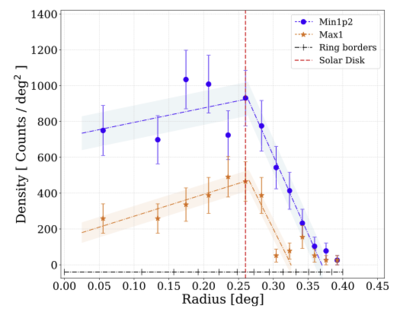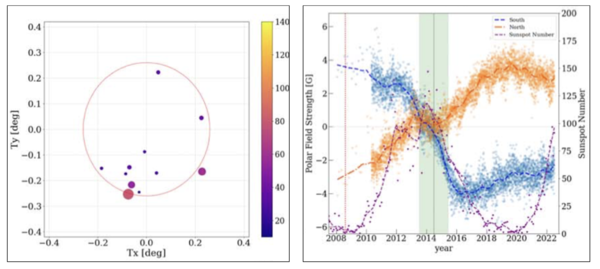Unexpected Asymmetry in GeV Emission
From RHESSI Wiki
| Nugget | |
|---|---|
| Number: | 466 |
| 1st Author: | Bruno ARSIOLI and Elena ORLANDO |
| 2nd Author: | |
| Published: | January 15, 2024 |
| Next Nugget: | TBD |
| Previous Nugget: | When it rippled in one place and exploded in another |
| List all | |
The Fermi Large Area Telescope (LAT) regularly observes high-energy (>20 MeV) γ-ray emission from the Sun, arguably resulting from the continuous bombardment of cosmic rays onto the solar atmosphere. By examining the Sun in these γ rays, we can gain insights on how cosmic rays interact with the heliosphere, and learn how solar conditions (e.g. solar activity, and solar magnetic configuration) affects the resulting gamma-ray emission. The physics involved here includes the transport of energetic charged particles (both primary and secondary), their interactions with matter and fields, and also the origins of the varying structure of the heliospheric magnetic field.
For reference we note that a 5-GeV proton is relativistic and has a Larmor radius of some 200 km at 1~G, and that its main energy losses should be to (p,p) nuclear reactions in or near the solar photosphere, in the absence of extended trapping in closed magnetic fields. The LAT angular response covers large areas of the sky, through which the Sun appears to move annually; accordingly great care in restricting the detected events to the solar direction. The restricted list can then be examined carefully for asymmetries or time variations as functions of photon energy. This Nugget, based on Ref. [1], describes the clear evidence for asymmetry in the angular distribution of the highest-energy photons.
Observations
We now have fourteen years of Fermi LAT data spanning from 2008 to 2022, and have investigated the morphology of solar γ-ray emission and explored its dependencies on the solar cycle (see also Ref. [2]). Figure 1 shows the radial distances of all γ-ray source positions for photon energies >5 GeV. This shows the sharp cutoff expected beyond the solar limb, as limited by the precision of the positions. It also compares solar (sunspot) minimum with solar maximum; as expected the larger cosmic-ray fluxes at minimum produce more radiation.
We have found compelling evidence for emission asymmetry, relative to the solar disk. This appears only at the highest energies, as shown in Figure 2. The most prominent asymmetry occurred around June 2014, which coincided with the solar polar magnetic field reversal during the solar maximum. Such a phenomenon occurs roughly once every decade, at times of sunspot minimum activity.
Model-independent Statistical tests (both Kolmogorov-Smirnov and Rayleigh) confirm the significance of these remarkable features.
Conclusion
The asymmetric concentration of only the highest-energy γ-ray photons near the S pole provides yet another mystery regarding solar global processes, but also may have implications for cosmic-ray transport in the heliosphere.
References
[1] "Yet Another Sunshine Mystery: Unexpected Asymmetry in GeV Emission from the Solar Disk"
[2] "First observations of solar disk gamma rays over a full solar cycle"
| RHESSI Nugget Date | 15 January 2024 + |
| RHESSI Nugget First Author | Bruno ARSIOLI and Elena ORLANDO + |
| RHESSI Nugget Index | 466 + |

